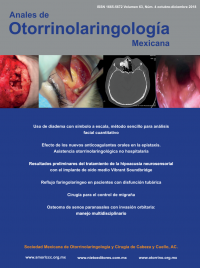Laryngopharyngeal reflux in patients with Eustachian tube dysfunction.
An Orl Mex. 2018 octubre-diciembre;63(4):150-158.
Alberto Jorge Ochoa-Moreno,1 Magdicarla Ercilia De Alba-Márquez,2 Raúl Durán-López3
1 Otorrinolaringólogo y cirujano de cabeza y cuello, egresado del Hospital Civil Fray Antonio Alcalde. Práctica privada, Guadalajara, Jalisco, México.
2 Otorrinolaringóloga, Maestra en Ciencias. Adscrita a la clínica de Otología, Servicio de Otorrinolaringología.
3 Otorrinolaringólogo, Maestro en Gerencia en Servicios de Salud, Jefe de la División de Cirugía.
Hospital Civil de Guadalajara Fray Antonio Alcalde, Jalisco, México.
Resumen
ANTECEDENTES: El reflujo faringolaríngeo se asocia con disfunción de la trompa de Eustaquio, por lo que conocer la relación entre ambas afecciones permite mejorar la evaluación y planeación terapéutica.
OBJETIVO: Analizar la relación entre la existencia de reflujo faringolaríngeo y el diagnóstico de disfunción de trompa de Eustaquio.
MATERIAL Y MÉTODO: Estudio de casos y controles, efectuado de julio a diciembre de 2015, que incluyó pacientes con disfunción tubárica y sujetos sin la enfermedad, pareados por edad y género. Se les realizó prueba de función tubárica para corroborar la existencia o ausencia de alteraciones tubáricas. Se realizó la evaluación del Índice de Síntomas de Reflujo y el Reflux Finding Score.
RESULTADOS: Se incluyeron 31 pacientes y 31 sujetos control. En pacientes con disfunción tubárica el Índice de Síntomas de Reflujo fue mayor (13.51 vs 9.80 puntos, p = 0.15), así como el Reflux Finding Score (6.48 vs 4.61 puntos, p = 0.07). El reflujo laringofaríngeo fue mayor en pacientes con disfunción tubárica (OR = 4.28, IC95%: 1.30–14.07, p = 0.01).
CONCLUSIONES: La existencia de reflujo faringolaríngeo en pacientes con disfunción tubárica fue significativamente mayor que en pacientes sanos, con cuatro veces más probabilidad de padecer disfunción de la trompa de Eustaquio asociada con reflujo faringolaríngeo.
PALABRAS CLAVE: Reflujo faringolaríngeo; disfunción de la trompa de Eustaquio.
Abstract
BACKGROUND: Laryngopharyngeal reflux is associated with Eustachian tube dysfunction (ETD), nowadays, there are few studies about this topic, so, it is required to study the relationship between both diseases.
OBJECTIVE: To analyze the relationship of laryngopharyngeal reflux with the diagnosis of Eustachian tube dysfunction.
MATERIAL AND METHOD: A study of cases and controls was done from July to December 2015, including patients with ETD and subjects without the disease, matched by age and gender. A tubal function test was performed to verify the presence or absence of ETD. All patients were subjected to the Reflux Symptom Index and the Reflux Finding Score.
RESULTS: There were included 31 patients and 31 control subjects. The score was higher in patients with ETD in the Reflux Symptom Index (13.51 vs 9.80 points, p = 0.15) and in the Reflux Finding Score (6.48 vs 4.61 points, p = 0.07). There was a greater presence of LPR in patients with ETD compared with patients without ETD (OR = 4.28, 95% IC: 1.30–14.07, p = 0.01).
CONCLUSIONS: The presence of LPR in patients with ETD was significantly higher than in healthy patients, with four times more likely of suffering ETD associated to LPR.
KEYWORDS: Laryngopharyngeal reflux; Eustachian tube dysfunction.


